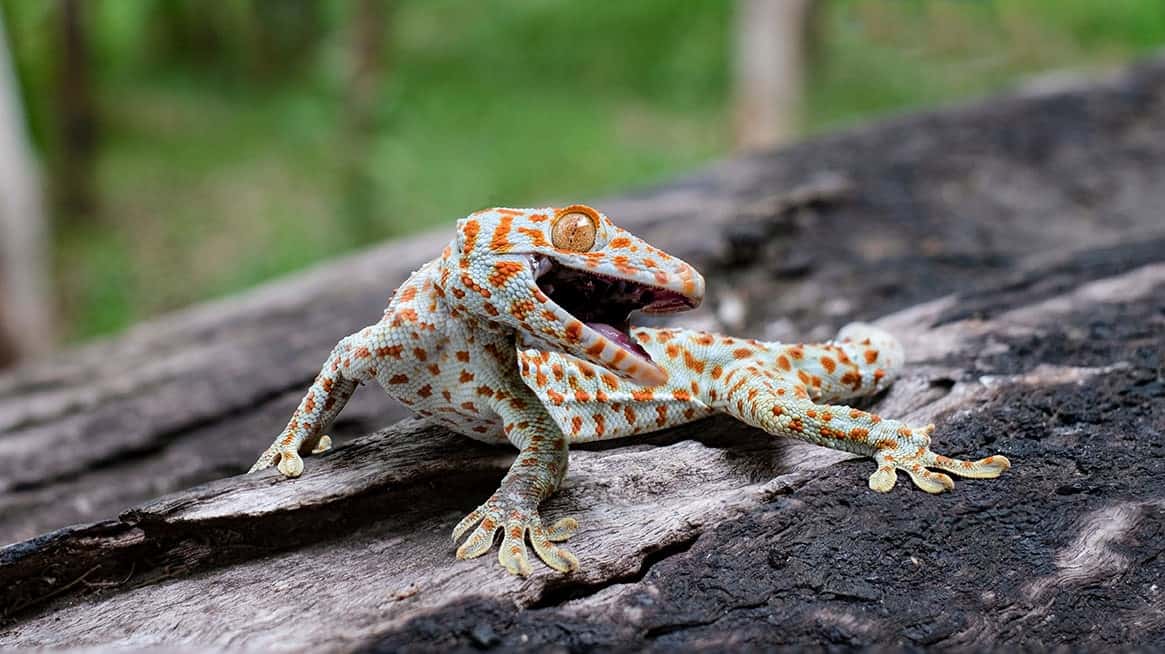You’ve probably seen a lizard if you’ve been to Florida. And if you live there, lizards are likely a common sight for you! These friends can get into your home or car and seem to be just about everywhere. While the Sunshine State is home to over 50 species of lizards, only 15 are native. All lizards play a role in the ecosystem. They prey on things considered pests, like insects and rodents, while being prey for snakes and other larger animals. Let’s take a look at the common species of lizards in Florida, both native and exotic.

The 10 Lizard Species Found in Florida
The 5 Small Lizards
These lizards are little native Florida friends. Some may be harder to spot than others, so here’s a list to help you distinguish them.
1. Green Anole
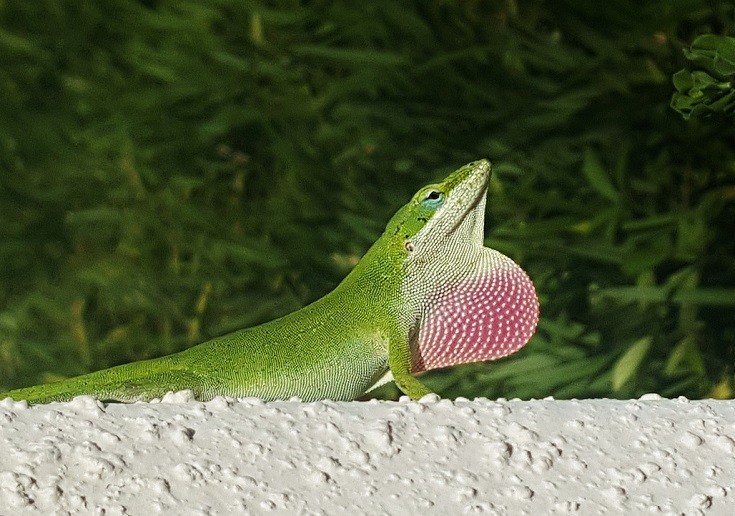
| Species: | Anolis carolinensis |
| Longevity: | 2 – 8 years |
| Good to own as a pet?: | Yes |
| Legal to own?: | Yes |
| Adult size: | 5 – 8 inches |
| Diet: | Crickets, worms, spiders, moths, and beetles |
The Green Anole is a common sight in Florida. They’re often mistaken for chameleons because they can change color. Their bodies are normally green, but they can change to brown, gray, or yellow. Their sticky feet help them climb. Male Green Anoles have a dewlap, or a little pink flap of skin, on their necks that turns red when the lizard is about to fight an enemy or try to attract a mate. You can find these lizards almost anywhere. They love to bask in the sun and hang out in yards and gardens in the warm months.
2. Six-Lined Racerunner

| Species: | Cnemidophorus sexlineatus |
| Longevity: | 6 years |
| Good to own as a pet?: | Yes |
| Legal to own?: | Yes |
| Adult size: | 6 – 9.5 inches |
| Diet: | Grasshoppers, crickets, and other insects |
Six-Lined Racerunners are almost always hanging out on the ground. You’ll find them in hot, dry areas that are open, like fields and dunes. They love the heat. They move quickly, often darting out to capture their prey after stalking it. You can identify this lizard by the six yellow lines going down the length of their bodies from head to tail. The tail itself accounts for half of the lizard’s body length and in some cases, can even be twice the length. They have dark green or black bodies, and the bellies are white or pale pink on females. For males, their bellies are pale blue with green throats. Rather than having a scaly, shiny appearance, these lizards have a velvety look to their skin.
3. Florida Scrub Lizard
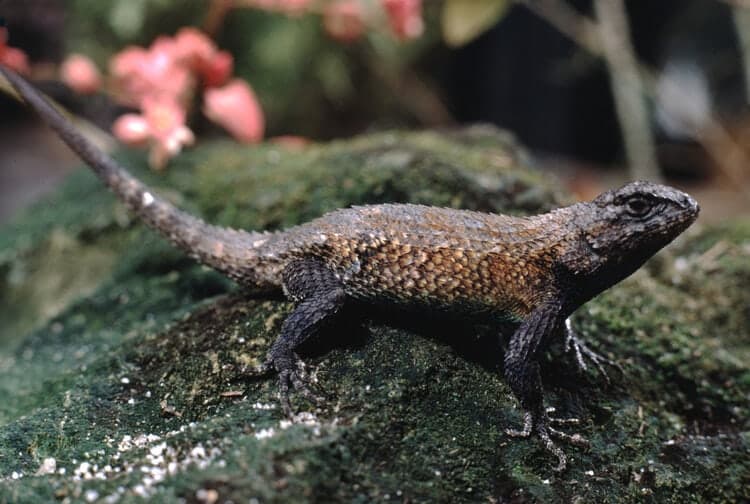
| Species: | Sceloporus woodi |
| Longevity: | 1.5 – 2.5 years |
| Good to own as a pet?: | No |
| Legal to own?: | Yes |
| Adult size: | 5.5 inches |
| Diet: | Ants, spiders, and other small anthropods |
In addition to being native to Florida, the Florida Scrub Lizard is only found in this state. At roughly 5.5 inches long, their tails account for 3 inches of their body length. Their brown or gray bodies are covered in rough scales, and there is a dark brown stripe on their sides from the neck to the tail. Males have bright blue patches on the sides of their bodies and their throats, while females either lack the blue patches altogether or have faint ones. You can find these lizards in sunny, sandy areas that have trees to offer shade. Scrub is their habitat of choice. Most of these lizards reside in the Ocala National Forest in the Sand Pine scrubs.
4. Eastern Fence Lizard

| Species: | Sceloporus undulatus |
| Longevity: | 1 – 5 years |
| Good to own as a pet?: | Yes |
| Legal to own?: | Yes |
| Adult size: | 4 – 7.5 inches |
| Diet: | Crickets, grasshoppers, and fruit flies |
This lizard is found on tree trunks and fence posts of Northern Florida and much of the Southeastern United States. They bask in the sun during the day. At night, they hide, taking cover under rocks and in logs and stumps. Their bodies are brown or black to help them blend in with their surroundings. It’s difficult to spot them because they cling to tree bark. Females are identified by dark horizontal stripes on their backs. Males have patches of blue on their undersides.
5. Reef Gecko
| Species: | Sphaerodactylus notatus |
| Longevity: | 10 – 20 years |
| Good to own as a pet?: | Yes |
| Legal to own?: | Yes |
| Adult size: | 2 – 2.5 inches |
| Diet: | Beetles, ants, and insect larvae |
The smallest lizard in North America is the Reef Gecko. Adults grow to be around 2 inches long, but hatchlings are 1 inch long when they’re born. They can be hard to spot because they like to hide under things like leaves and vegetation to hunt for insects. They are active at dusk. Their scales are light brown, and they’re covered in dark brown spots all over their bodies. The females can be distinguished by three dark, wide stripes on their heads. Birds, snakes, and other lizards eat the Reef Gecko. Their coloring helps them hide in their surroundings to escape predators.

The 5 Big and Invasive Lizards
The following lizards are not only large, but they’re also not native to Florida. These big, invasive species are ones to look out for because some can be harmful to people.
6. Brown Anole
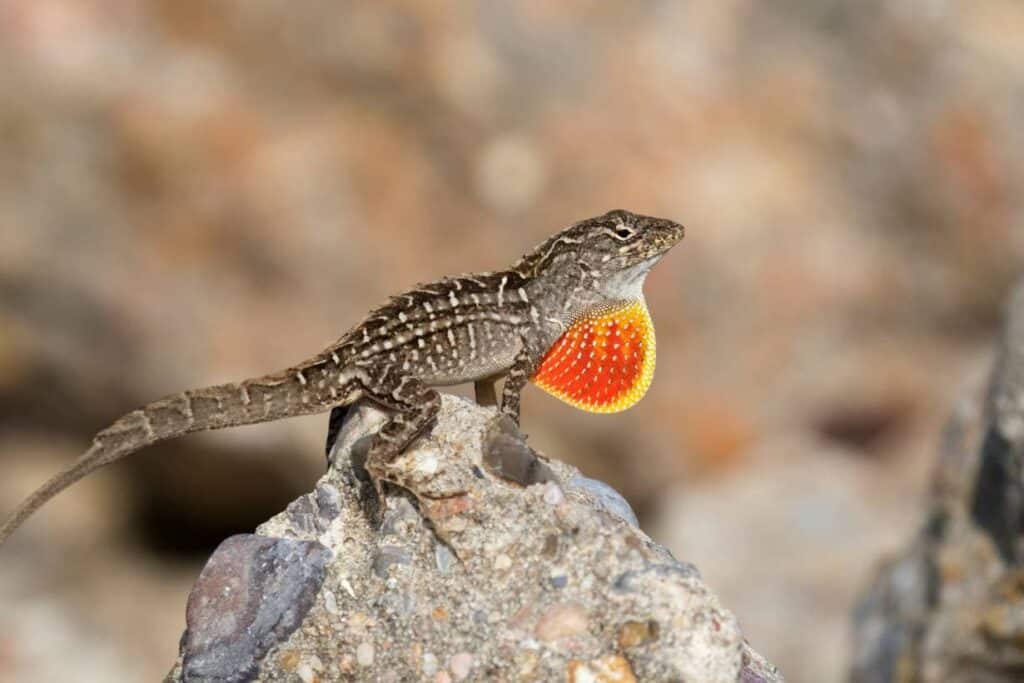
| Species: | Anolis sagrei |
| Longevity: | 1.5 – 5 years |
| Good to own as a pet?: | No |
| Legal to own?: | Yes |
| Adult size: | 9 inches |
| Diet: | Insects, other lizards, lizard eggs, and their own detached tails |
Not only will these lizards eat their own molted skin and detached tails, but they will also eat their own hatchlings and the hatchlings of the Green Anole. Since this invasive species arrived in Florida from Cuba, there’s been a decrease in the Green Anole population. Brown Anoles have wider heads and shorter noses than other Anoles. They have long toes that enable them to move quickly, and they can attach to any surface as they climb, even glass. Their bodies are light brown with black-and-white markings on their backs and light tan lines on their sides. Like the Green Anole, the Brown Anoles have dewlaps, which are reddish-orange. They’re active during the day and love humidity. These lizards can thrive in any environment but prefer ground vegetation and places that they can bask in the sun.
7. Green Iguana
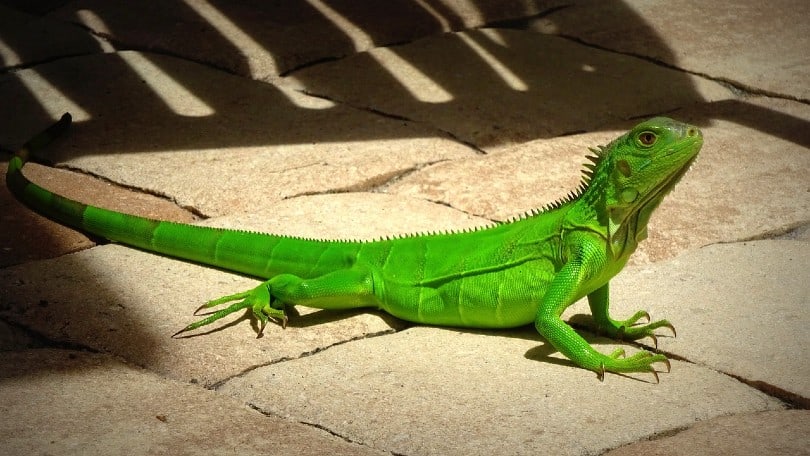
| Species: | Iguana iguana |
| Longevity: | 12 – 15 years |
| Good to own as a pet?: | No |
| Legal to own?: | Yes |
| Adult size: | 12 – 60 inches |
| Diet: | Leaves, plants, fruit, and flowers |
This lizard is considered an invasive species in Florida. The Green Iguanas are native to the tropical rainforests of Central and South America. In Florida, they are considered nuisance animals, destroying vegetation and crops. They also cause damage to property by digging burrows that can collapse walkways and foundations. These large creatures might be called green, but they can be a variety of colors, including blue, lavender, brown, red, black, and orange. They can detach their long tails from their bodies if they are grabbed by them, allowing the lizard to flee to safety and eventually grow a new tail. Green Iguanas have jagged dewlaps that regulate their body temperatures. In warm weather, you can find Green Iguanas in trees. They’re good climbers, and if they do fall, they often land without injury. They have sharp teeth and can pierce human skin with their bites.
8. Argentine Black and White Tegu

| Species: | Salvator merianae |
| Longevity: | 15 – 20 years |
| Good to own as a pet?: | No |
| Legal to own?: | Yes |
| Adult size: | 60 inches |
| Diet: | Insects, snails, rodents, fruits, and eggs |
These lizards are invasive and pose a threat to Florida’s wildlife, eating the eggs of other species and causing destruction. They’re huge and resemble an alligator, but they have a black-and-white banded pattern down their backs and tails. They’re usually found near water and are good swimmers. Argentine Black and White Tegus are typically not aggressive to humans but will bite if they feel threatened. They have strong jaws and produce a painful, damaging bite. Luckily, heavy breathing, tail thrashing, and feet stamping are all telltale signs that you should leave the Tegu alone and get away from them. They have been known to charge people and bite if these signs aren’t taken seriously.
9. Tokay Gecko
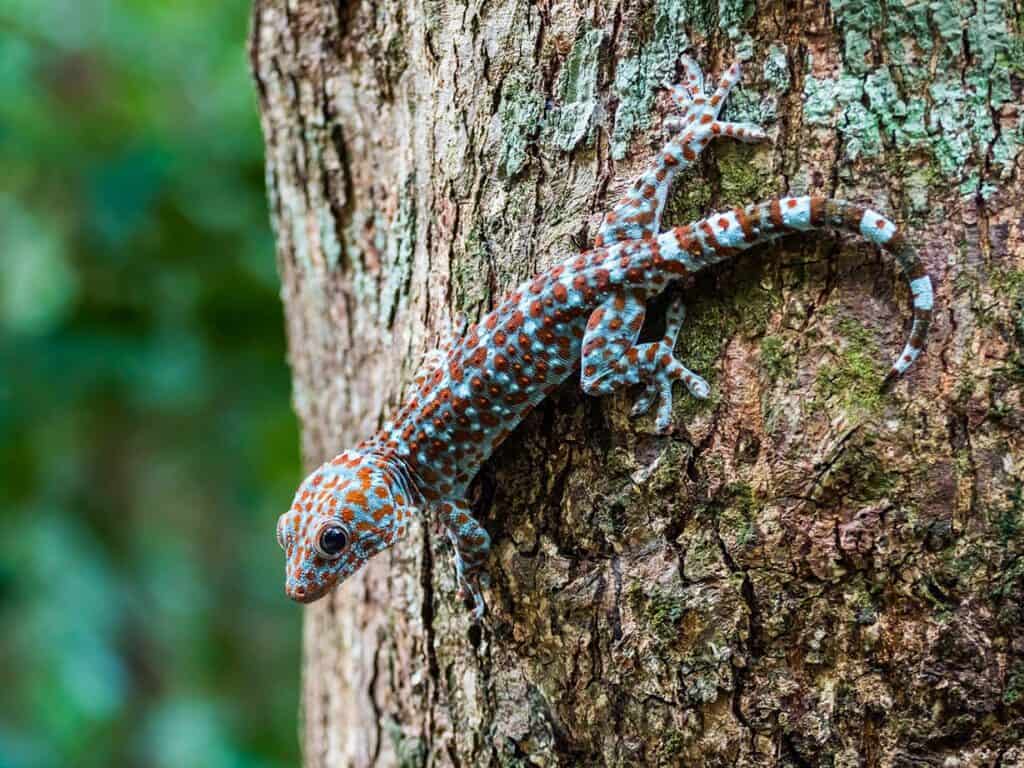
| Species: | Gekko gecko |
| Longevity: | 10 years |
| Good to own as a pet?: | No |
| Legal to own?: | Yes |
| Adult size: | 13 –16 inches |
| Diet: | Small rodents, moths, crickets, cockroaches, and mosquitos |
The Tokay Gecko is a large gecko species native to South Asia. These invasive lizards can detach their tails to avoid capture by a predator. The tails will thrash around, confusing the attacker, while the Gecko can slip away. There are two kinds of Tokay Geckos: black-spotted and red-spotted. These spots cover a stocky blue-gray body. While they can typically be found in Florida in rocky or tropical environments, they can also make their homes in the walls of houses. Most people don’t mind this because these lizards can serve as natural pest control. They’re extremely fast and can draw blood with a single bite. The Tokay Gecko will clamp down and not let go. If you try to make this lizard release their grip, they will only grip tighter. They can pass bacteria to humans through their saliva in a bite wound, including salmonella.
10. Nile Monitor
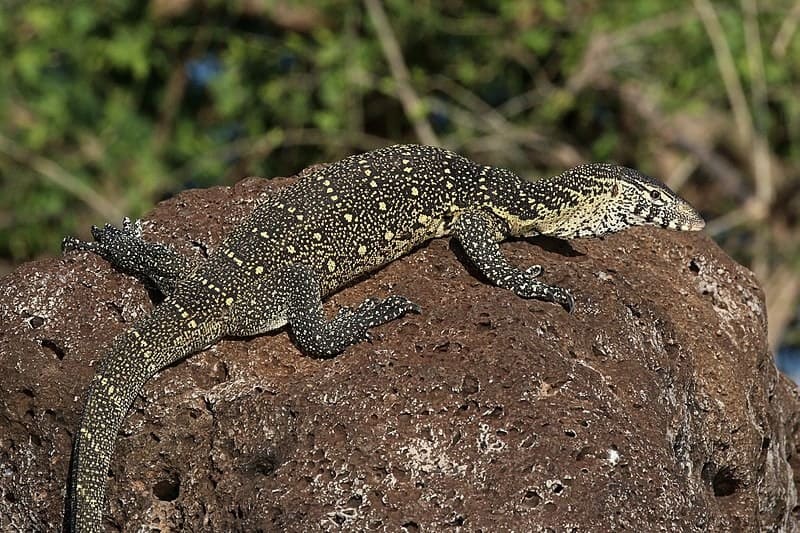
| Species: | Varanus niloticus |
| Longevity: | 20 years |
| Good to own as a pet?: | No |
| Legal to own?: | Yes |
| Adult size: | 70 – 80 inches |
| Diet: | Crabs, frogs, turtles, birds, and small mammals |
You can find this invasive lizard near water in Florida. Nile Monitors are olive green or black with long, thick bodies. They have cream or yellow stripes on their jaws and head that lead into bands and spots down their backs. They’re good swimmers and can stay underwater for 15 minutes. They bask in the sun near the water on branches and rocks. This lizard is venomous but usually not fatal to humans. The poison will kill their prey and is dangerous to small animals. These lizards won’t attack a human unless they feel threatened, so if you encounter them, leave them alone and back away from their area. Nile Monitors are aggressive in captivity and don’t want to be tamed. Most bite wounds to humans are the result of people trying to keep these lizards as pets.

Conclusion
There are many species of lizards in Florida, but most are harmless. From very small to extremely large, these lizards can be found in various places all over the state. While no lizards in Florida pose a threat to human life, some can be considered nuisance animals. The Nile Monitor, Tokay Gecko, Argentine Black and White Tegu, and the Green Iguana are lizards that can deliver painful and sometimes bacteria-filled bites. This list might help you determine which lizards are harmless and which lizards should be avoided if you encounter one.
Featured Image Credit: Thichaa, Shutterstock
